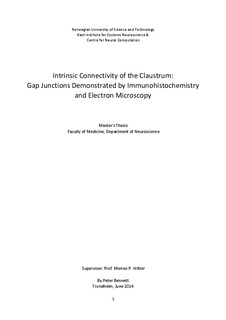| dc.description.abstract | The claustrum is a much neglected nucleus in the brain, whose fuction remains unknown to date. Yet, based on the extensive reciprocal connections it shares with virtually all functional regions of cortex, it most likely serves a far from meaningless purpose. Current hypotheses propose a role in perceptual binding by synchronization of cortical activity. These hypotheses come with a number of assumptions, such as a wide network of connections intrinsic to the claustrum. In this context, gap junctions have been suggested as a means to interconnect portions of the claustrim and to synchronize incoming cortical activity. Neuronal gap junctions have been shown to be involved in supporting synchronous activity and oscillations in areas such as the hippocampus, making them a feasible candidate for such a mechanism in the claustrum. While gap junctions have been described in many areas of the brain, they have not been observed in the claustrum prior to the present study. Set aginst this background, the presence of gap junctions in the claustrum was investigated in this thesis. To this end, an immunohistochemical approach was first used to localize the gap junction protein connexin 36. Once a protocol was established, a small population of connexin 36 expressin neurons was identified in the posterior half of the dorsomedial aspect of the ventral claustrum (also known as the endopiriform nucleus). However, no further labeling was observed throughout the rest of the claustrum. These results were supported by electron microscopy, as putative gap junctions were exclusively observed in an area corresponding to where connexin 36 expression was found. These results represent the first steps in confirming the presenceof the hypothesized gap junction network in the claustrum. Yet, it could be argued that their limited occurrence in both number and location are not entirely in line with current hypotheses predicting a wide gap junction network common to the entire claustrum. | nb_NO |


